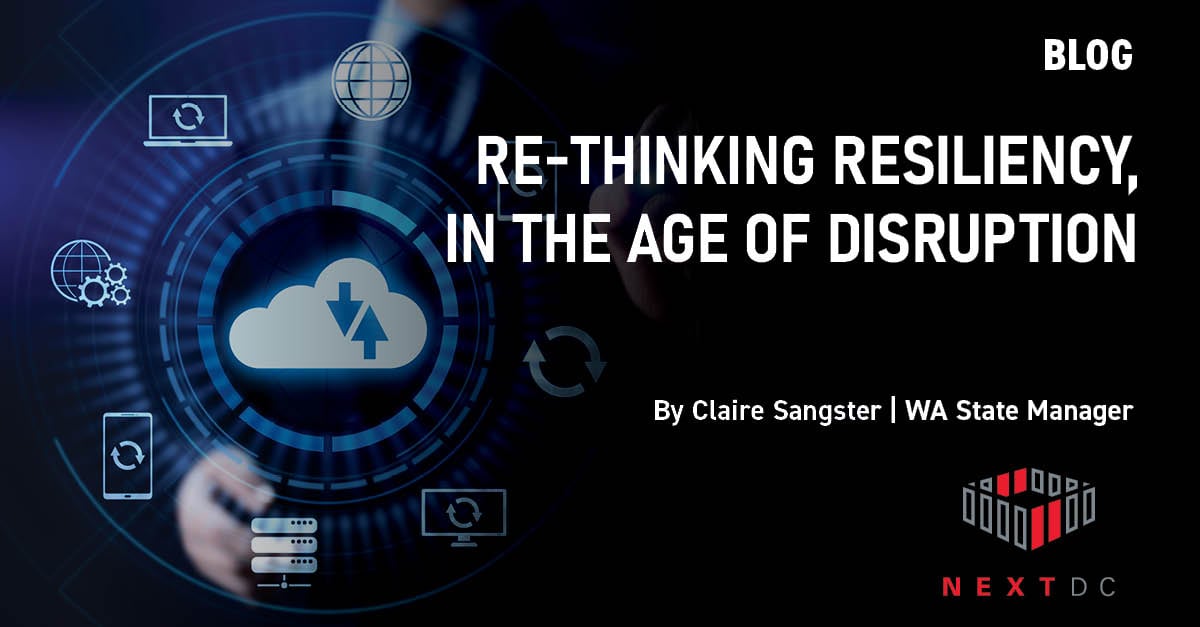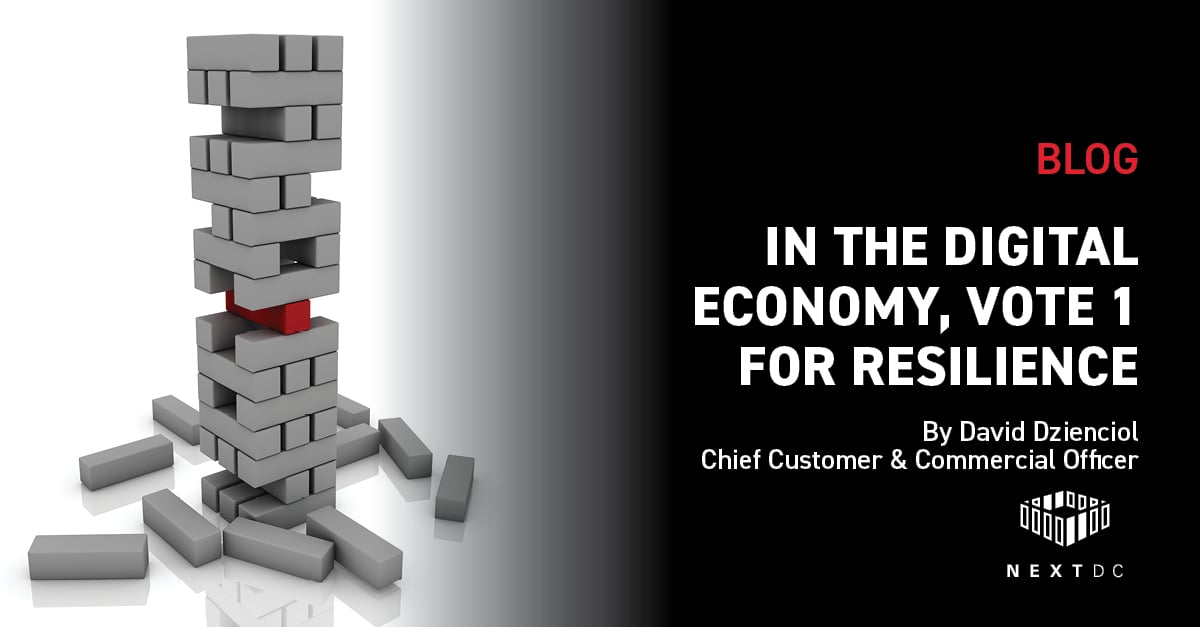By David Dzienciol, Chief Customer and Commercial Officer
Data centre outages or breaches cause irreparable damage and costly disruptions that wreak havoc on business operations.
Gartner estimates downtime costs about $5,600 per minute – anywhere from $140,000 and $540,00 per hour depending on the organisation. Lost sales; damage to your brand; reduced productivity; lost data are an example of the carnage that follows.
What’s more, a growing number of businesses have experienced downtime or severe interruption at some point over the last few years, according to Uptime Institute’s latest annual Data Centre Survey.
So, what’s causing the conundrum? A mix of human error (considered the single largest cause of most technology failures with switching procedures proving particularly risky in data centre environments); network failure; power outages; UPS system failure; natural disasters, and cybercrimes – are considered just some of the most prominent culprits.

Reliability Underpins Success
Certainly, there’s no room for IT infrastructure inefficiencies. IT is the engine room in business, it underpins growth and ultimately an organisation’s success. This is why the reliability of infrastructure cannot be understated – and is such a critical factor in business success today, according to CISO Lens industry analyst – and emeritus adviser at IBRS - James Turner.
Addressing why reliability matters, the Uptime Institute cite three key issues:
- Increasing scope and frequency of outages
- The actual rate at which migration to cloud is occurring, and
- Increasing complexity of hybrid infrastructures and their resilience, and the resulting performance expectations.
Like Turner, Ecosystm principal advisor, Andrew Milroy, says “reliability of infrastructure is crucial” because businesses areintrinsically dependent on technology.
Indeed, ‘reliability’ has become a mammoth word in the data centre customer’s lexicon. It affects the daily lives of businesses on a grand scale, and chillingly is a ‘do or die’ necessity - without it, organisations simply aren’t equipped to act fast and fail fast. Sadly, they will struggle to survive.
If 2020 taught us anything – from technological upheaval and shifting work requirements, to shifting business models entirely - it’s the fact that ‘digital resilience’, which delivers seamless experiences and continuous uptime, is a requisite for success.
The cost of procrastination
On the flip side, inaction – which fosters unreliability and ‘poor digital resilience’ – causes a host of concerns, namely:
- Increased frequency and duration of outages
- Poor or unreliable network performance and application response times
- Inability to respond quickly, and adapt to change; and
- Churn – resulting in reduced customer retention and acquisition.
Putting reliability first
Data centre outsourcing continues to gain traction as organisations look to bolster the efficiency, and sustainability of their own infrastructure operations.
One of our key customers, Data Processors, are a data-centric research and technology services company. These guys are serious players in analysis and statistical modelling. Their core business is managing enormous volumes of statistical information, so they have an inherent dependence on highly reliable infrastructure.
When we first met with the customer, they had identified obstacles from within their on-premises data centre, which was struggling to keep up with the dynamic nature of their business. The company was under pressure to service surging infrastructure requirements – and needed to deal with consistent growth in operations, and consistently high volumes of data.
One of the most prominent risks identified to Data Processors operations was their current facility’s inability to maintain 100% uptime.
They were looking for a solution that would help them overcome the challenges that posed a direct threat to growth and customer-centric priorities, which led them to partner with NEXTDC to house their complex and highly customised production environment.
Preparedness Checklist
So, what’s the answer? Better still, what questions should businesses be asking on the reliability front?
Partnering with a data centre provider that guarantees resiliency and availability – and actively champions the crucial role IT infrastructure plays in any organisation’s growth strategy – is imperative.
Businesses must have confidence that their IT infrastructure has the level of availability and reliability that they consider appropriate and sustainable for their needs.
Reliability is the cornerstone that helps minimise downtime, and the potential downstream effects it creates including: network interruptions; service quality issues; overheated equipment – all symptoms of poor digital resilience.
Businesses need the assurance their infrastructure will bend and flex with all the neck jarring twists and turns that come in a world where the one constant, is change. Not being able to rely on the engine that drives business introduces additional risk that organisations need to prioritise and respond to.
Reliability factors to consider:
- Availability – Are the highest levels of availability and redundancy built in: if there’s a disaster or power outage, what’s the backup strategy?
- SLAs – What’s the power SLA that supports the data centre infrastructure? Are operations built and run to the highest global standards in order to mitigate the risk of mishaps and safeguard business operations?
- Energy efficiency – How do you stay ahead in a data economy, yet keep costs down without sacrificing reliability – all whilst operating responsibly and sustainably?
- Health and safety – What systems are in place to deal with emergencies like fire, and are they tested regularly? What are the ongoing safety measures to protect staff and customers in what is largely understood as high-risk environments?
- Security – What are the layers of security in place? What do the physical security procedures and protocols comprise of?
- Management – Do you have reliable resources to run and manage your infrastructure given the shortage of skilled data centre staff?
Reliable Partners
2020 was an eye opening 12 months, yet amidst the change, organisations are leaning on their IT infrastructure more than ever. Ensuring they maintain the highest levels of reliability is imperative.
We live in a data economy. As such, our mission is ongoing as we support our customers through their evolving transformation journeys and beyond – clearing a path so they continue to focus on growth and innovation while also alleviating themselves of their most pressing challenges and risks.
In the information age, data and its availability have formed the single most important currency in which business needs to thrive. The unavailability, or poor performance from digital systems has a marked impact on productivity, customer experience and the bottom line. These strategic digital assets now form the heart of every digital business, and without reliable critical infrastructure like NEXTDC’s, there is no heartbeat.
The quality of our digital infrastructure is widely recognised. Reliability and resilience are deeply intertwined in the values of our company and our brand promise. We are honoured to be recognised as Australia’s leading data centre provider, and Australia’s most reliable data centre provider. But importantly, our greatest accomplishments are the partnerships we form with our customers, and the role we play in helping them achieve their objectives.
If we can help you improve the reliability of your critical infrastructure, reach out to our team.


